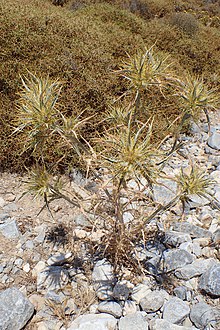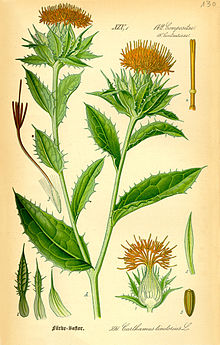Safflower
| Safflower | ||||||||||||
|---|---|---|---|---|---|---|---|---|---|---|---|---|

Safflower ( Carthamus tinctorius ) |
||||||||||||
| Systematics | ||||||||||||
|
||||||||||||
| Scientific name | ||||||||||||
| Carthamus | ||||||||||||
| L. |
The safflower ( Carthamus ) are a genus within the family of the daisy family (Asteraceae). The natural range of about 14 species extends from the Mediterranean area to the Middle East .
description


The safflower species are upright, thistle-like, annual or perennial herbaceous plants that reach heights of 30 to 180 centimeters. Their thorny, elongated leaves can be bald or hairy.
The cup-shaped inflorescences contain 15 to over 60 yellow, red to purple tubular flowers . They form achenes .
Systematics


The genus Carthamus was established by Carl von Linné . A synonym for Carthamus L. is Kentrophyllum Neck. ex DC. The genus Carthamus belongs to the subtribe Centaureinae from the tribe Cardueae in the subfamily Carduoideae within the family Asteraceae . The genus Carthamus is divided into only the two sections Section Atractylis and Section Carthamus .
There are about 14 (13 to 17) species in the genus Safflower ( Carthamus ):
- Carthamus boissieri Halácsy : It occurs only in Crete and Cyprus .
- Carthamus creticus L. (Syn .: Carthamus baeticus (Boiss. & Reut.) Pérez Lara , Carthamus lanatus subsp. Creticus (L.) Holmboe , Carthamus lanatus subsp. Baeticus (Boiss. & Reut.) Maire , Kentrophyllum baeticum Boiss. & Reut. ): It iswidespreadin southern Europe , northern Africa and western Asia .
- Carthamus curdicus Hanelt : It only occurs in Iraq .
-
Carthamus dentatus Vahl : It is distributed in two subspecies in southeastern Europe, in Turkey , in Cyprus, Syria , Lebanon and in Iran :
- Carthamus dentatus subsp. dentate
- Carthamus dentatus subsp. ruber (Link) Hanelt : It occurs in Greece, Crete, the Aegean Sea, Turkey and Cyprus.
- Carthamus divaricatus Bég. & Vacc. : It only occurs in Libya.
-
Carthamus glaucus M.Bieb. : The roughly four subspecies arewidespreadin Egypt, Libya, Southeast Europe , Eastern Europe , Western Asia and in the Caucasus :
- Carthamus glaucus subsp. alexandrinus (Boiss. & Heldr.) Hanelt (Syn .: Carthamus alexandrinus (Boiss. & Heldr.) Asch. , Kentrophyllum alexandrinum Boiss. & Heldr. ): It occurs in Egypt and Libya .
- Carthamus glaucus subsp. anatolicus (Boiss.) Hanelt (Syn .: Carthamus anatolicus (Boiss.) Sam. ex Rech. f. ): It occurs in Syria, Jordan and Isael.
- Carthamus glaucus subsp. glandulosus Hanelt (Syn .: Carthamus syriacus (Boiss.) Čelak. ): It occurs in Lebanon.
- Carthamus glaucus subsp. glaucus
-
Woolly safflower ( Carthamus lanatus L. ): It is widespread in southern, eastern and central Europe , North Africa and Asia and is a neophyte in North and South America, Australia, New Zealand and South Africa . The woolly safflower belongs with Carthamus creticus and Carthamus turkestanicus to a group of species that are also known as Carthamus lanatus agg. are designated. Other authors list these clans as subspecies of a species:
- Carthamus lanatus subsp. lanatus
- Carthamus lanatus subsp. turkestanicus (Popov) Hanelt (Syn .: Carthamus turkestanicus Popov )
- Carthamus leucocaulos Sm . : The homeland is Greece .
- Carthamus nitidus Boiss. : The homeland is Syria, Lebanon , Israel and Jordan .
- Carthamus oxyacantha M.Bieb. (Syn .: Carthamus flavescens Willd. ): It iswidespreadin West, South and Central Asia .
- Carthamus palaestinus Eig ex Rech. F. : The homeland is Israel, Jordan and western Iraq .
- Carthamus persicus Desf. ex Willd. (Syn .: Carthamus flavescens auct.): It is distributed from Turkey via Syria, Lebanon, Iraq to Iran.
- Carthamus tenuis (Boiss. & Blanche) Bornm. (Syn .: Kentrophyllum tenue Boiss. & Blanche ): The home is Lebanon and Turkey.
- Safflower or safflower ( Carthamus tinctorius L. ): It is believed to originate from West Asia and is cultivated in many areas of the world. It is naturalized worldwide.
- Carthamus turkestanicus Popov (Syn .: Carthamus lanatus subsp. Turkestanicus (Popov) Hanelt ): It is common in Turkey, Iran, Armenia and the Pakistani part of Kashmir .
The species of the Carthamus sect. Thamnacanthus (DC.) Hanelt were placed in the genus Carduncellus , for example:
- Carthamus arborescens L. → Carduncellus arborescens (L.) Sweet : It occurs in southern Spain , Gibraltar , Algeria and Morocco .
- Carthamus atractyloides (Pomel) Greuter → Carduncellus atractyloides Pomel
- Carthamus balearicus (JJRodr.) Greuter → Carduncellus balearicus (JJRodr.) G.López
- Carthamus caeruleus L. → Carduncellus caeruleus (L.) C. Presl
- Carthamus calvus (Boiss. & Reut.) Batt. → Carduncellus calvus Boiss. & Reut.
- Carthamus carduncellus L. → Carduncellus monspelliensium All.
- Carthamus catrouxii (Maire) Greuter → Carduncellus catrouxii Maire
- Carthamus cespitosus (Batt.) Greuter → Carduncellus cespitosus Batt.
- Carthamus chouletteanus (Pomel) Greuter → Carduncellus chouletteanus (Pomel) Batt.
- Carthamus dianius (Webb) Sch.Bip. → Carduncellus dianius Webb
- Carthamus duvauxii (Batt. & Trab.) Prain → Carduncellus duvauxii Batt. & Trot.
- Carthamus eriocephalus (Boiss.) Greuter → Carduncellus eriocephalus Boiss.
- Carthamus fruticosus Maire → Carduncellus fruticosus (Maire) Hanelt
- Carthamus helenioides Desf. → Carduncellus helenioides (Desf.) Hanelt
- Carthamus hispanicus (Boiss. Ex DC.) Sch.Bip. → Carduncellus hispanicus Boiss. ex DC.
- Carthamus hispanicus subsp. macrocephalus (Cuatrec.) Greuter → Carduncellus cuatrecasii G.López
- Carthamus rhiphaeus Font Quer & Pau → Carduncellus rhiphaeus (Font Quer & Pau) G.López
swell
- David J. Wedge: Carthamus. In: Flora of North America Editorial Committee (Ed.): Flora of North America North of Mexico . Volume 19: Magnoliophyta: Asteridae, part 6: Asteraceae, part 1 (Mutisieae – Anthemideae). Oxford University Press, New York / Oxford a. a. 2006, ISBN 0-19-530563-9 , pp. 178 (English). , online. (Distribution section)
- Victoria G. Bowles, Reinhold Mayerhofer, Corey Davis, Allen G. Good, Jocelyn C. Hall: A phylogenetic investigation of Carthamus combining sequence and microsatellite data. In: Plant Systematics and Evolution , Volume 287 2010, pp. 85-97. (Section systematics)
- G. López González: Sobre la clasificación del complejo Carthamus - Carduncellus (Asteraceae, Cardueae-Centaureinae) y su stratamiento en Flora Iberica. In: Acta Botánica Malacitana , Volume 37, 2012, p. 83. Full text PDF. (Section systematics)
Individual evidence
- ↑ a b c d e f g h i j k l m n o p q r s Carthamus in the Germplasm Resources Information Network (GRIN), USDA , ARS , National Genetic Resources Program. National Germplasm Resources Laboratory, Beltsville, Maryland. Retrieved May 8, 2014.
- ↑ a b c d Werner Greuter (2006+): Compositae (pro parte majore). - In: W. Greuter & E. von Raab-Straube (eds.): Compositae. Euro + Med Plantbase - the information resource for Euro-Mediterranean plant diversity. Datasheet Carthamus In: Euro + Med Plantbase - the information resource for Euro-Mediterranean plant diversity.


